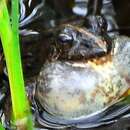Description
(
englanti
)
tarjonnut AmphibiaWeb articles
Size of male: 30-43 mm, female: 32-50 mm Colour of dorsum is green with dark spots and with a yellow mid-vertebral band. Belly whitish-yellow. Vocal sacs and throat speckled with grey.F. greenii belongs to th F.limnocharis group and is distinguished from F. limnocharis by its longer fingers and toes, less webbing between the toes, and uninterrupted longitudinal ridges on the dorsum. The tadpoles of F. greenii differ from those of F. limnocharis by having a dark pigmented tail fin.
Distribution and Habitat
(
englanti
)
tarjonnut AmphibiaWeb articles
Terra typica: Punduloya, Central Ceylon [Sri Lanka] Endemic to Sri Lanka. A montane species, having been recorded at altitudes above 1700 m asl in the central hills. This frog can be found in margins of shallow, slow-flowing streams, and under grass tussocks in marshes and smal water holes.
Life History, Abundance, Activity, and Special Behaviors
(
englanti
)
tarjonnut AmphibiaWeb articles
This frog is active during daytime and can be found in leaf litter near streams inside forest. In the Horton Palins, alarge breeding aggregation of about 20-30 specimens was observed. I found F. greenii in open ponds in Hakgala Botanical Garden swimming and barking at the surface in daytime. Juveniles of SVL 13-19,6 mm were observed on 19 March 1994 and of SVL 19,4-22,6 mm on 10 August 1995 at the Horton Plains and at Ohiya.
Relation to Humans
(
englanti
)
tarjonnut AmphibiaWeb articles
I found F. greenii in Hakgala Botanical Garden.

